QUESTIONS
SECTION A (30 marks)
Answer all the questions in this section in the spaces provided.
- Name the two products obtained from dual purpose sheep.(1 mark)
- Give two practices that should be done to a newly born calf with difficult breathing.(1 mark)
-
- What is meant by the term two host tick?(1 mark)
- Give two examples of two host ticks in cattle.(1 mark)
- State four disadvantages of using plunge dips in tick control.(2 marks)
-
- State the functions of the following farm tools and equipment:
- pipe cutter;(1/2 mark)
- wire strainer.(1/2 mark)
- Name four tools that can be used to assemble a jembe.(2 marks)
- Name the complementary tool for each of the tools named below:
- trochar;(1/2 mark)
- hand drill(1/2 mark)
- State the functions of the following farm tools and equipment:
- Name two livestock diseases controlled through embryo transplant.(1 mark)
- State three factors that limit external parasite control in Kenya.(11/2 marks)
- State four characteristics of the Duroc Jersey pig.(2 marks)
- Name four categories of poultry feeds according to the stages of growth of birds.(2 marks)
- State four ways in which a vaccine can be administered to livestock.(2 marks)
-
- Name three protozoan diseases of cattle.(1 marks)
- State four symptoms of rinderpest in cattle.(2 marks)
- State four maintenance practices carried out on a spray race.(2 marks)
-
- Give four reasons for proper feeding in livestock rearing.(2 marks)
- State four good hygiene practices in livestock feeding,(2 marks)
- State four reasons why kids should be weighed immediately after birth.(2 marks)
SECTION B (20 marks)
Answer all the questions in this section in the spaces provided.
- The picture below shows a poultry farm structure.
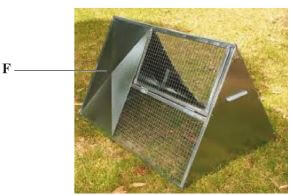
- Identify the farm structure.(1 mark)
- Apart from metal, name two materials that can be used for the part labelled F. (2 marks)
- State three disadvantages of using the farm structure illustrated above in poultry rearing.(3 marks)
- The picture below illustrates a livestock organ infested by a parasite labelled E.
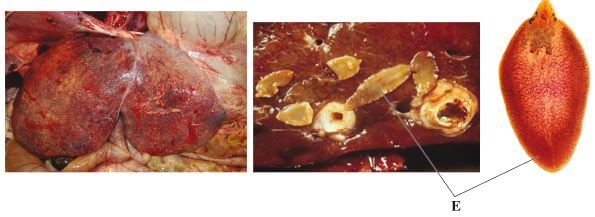
- Name the disease the livestock is suffering from.(1 mark)
- Identify the parasite labelled E.(1 mark)
- State two control measures for the parasite.(2 marks)
- State two signs of infestation shown in the picture above.(2 marks)
- The pictures below illustrate two rabbit breeds.
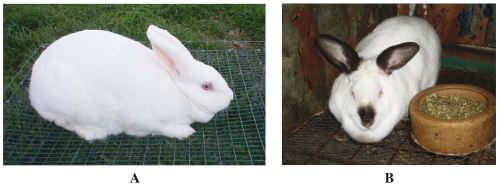
- Name the rabbit breeds shown above.(2 mark)
- Name the major feeding practice missing from the photograph labelled B.(1 mark)
- Give one advantage of housing the rabbits on the floor illustrated above.(1 mark)
- The following is an illustration of a chick suffering from malnutrition.
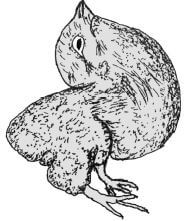
- Identify the mineral deficiency shown by the chick.(1 mark)
- Apart from the symptom illustrated above, give three other symptoms of mineral deficiency in poultry(3 marks)
SECTION C (40 marks)
Answer any two questions from this section in the spaces provided after question 21.
-
- Describe upgrading as a method of improving indigenous cattle for milk production.(8 marks)
- Describe the causes of low egg production in layers.(12 marks)
-
- Describe how the late weaning programme is conducted in a dairy calf.(12 marks)
- Describe how a newly constructed pond is prepared and stocked with fingerlings.(8 marks)
-
-
- Describe short-term tractor servicing(10 marks)
- Explain the maintenance practices that should be carried out on an ox-cart.(5 marks)
- State five indicators that can be observed on a goat to confirm sickness.(5 marks)
-
MARKING SCHEME
-
- Wool;
- Meat;2 x 1/2 (1 mark)
-
- Place salt on tongue;
- Pour cold water on head and chest to activate the nerves;
- Clear the mucus from the nostrils;
- Hold upside down using hind legs and swing the calf.
- Smack the ribs.2 x 1/2 (1 mark)
-
- One that requires two hosts to complete its life cycle.(1 mark)
-
- Red legged tick/rhipicephalus everts;
- Brown tick/rhipicephalus bursa;
- African bont-legged tick/hyalomma truncatum;
- The large bont-legged tick/hyalomma rufipes;2 x 1/2 (1 mark)
-
- High initial construction cost (high capital);
- Dangerous for young and pregnant animals and the sick;
- Requires a lot of water;
- Poisoning by swallowed dip wash;4 x 1/2 (2 marks)
-
-
- Cutting PVC pipes; (1/2 mark)
- Wire strainer - to tighten wires during fencing; (1/2 mark)
-
- Cross-cut saw;
- Spoke shave;
- Wood rasp;
- Mallet (to drive in wood and for hammering wood);4 x 1/2 (2 marks)
-
- Canular (1/2 mark)
- Bit (1/2 mark)
-
-
- Vaginitis eg. Bovine Trichomoniasis.
- Brucellosis (contagious abortion/Bang's disease
- Vibriosis2 x 1/2 (1 mark)
-
- Acaricide resistance
- High Cost of acaricide
- Communal rearing practices
- Lack of skills and knowledge in control of external parasite.
- Some are highly mobile/high mobility eg tsetse flies.3 x 1/2 (11/2 marks)
-
- Long body
- Black in colour
- Drooping ears
- Is hardy;4 x 1/2 (2 marks)
-
- Chick mash;
- Growers mash;
- Layers mash;
- Broiler starter;
- Broiler follow-on;
- Broiler finisher;4 x 1/2 (2 marks)
-
- Injection
- Oral (through the mouth)
- Nasal (through nose)
- Occular (through the eye)
- cloacal4 x 1/2 (2 marks)
-
-
- ECF/Theileriosis
- Anaplasmosis/Gall stones
- Coccidiosis
- Trypanosomiasis/Nagana
- Red water/Babesiosis3 x 1/2 (11/2 marks)
-
- Fever
- Starring coat
- Discharges in the mouth and nose
- Watery eyes/lacrimation
- Diarrhoea and dysentry
- Red mucal membranes with ulcers
- Tooth grinding
- Emaciation
- Dullness
- Loss of appetite/anorexia4 x 1/2 (2 marks)
-
-
- Unblocking blocked nozzles
- Replacing water in the tank
- Tightening loose nuts/bolts
- Repairing damaged floor
- Sump should be cleaned regularly by removing all the sediments
- Broken rails should be replaced4 x 1/2 (2 marks)
-
-
- Increase production
- Protection against diseases
- Reproduction
- Maintenance
- Increase quality of products.4 x 1/2 (2 marks)
-
- Cleaning feeders
- Cleaning waterers
- Provide fresh water
- Provide fresh feeds
- Provide adequate waterers
- Provide adequate feeders
- Provide clean water
- Provide clean feeds 4 x 1/2 (2 marks)
-
-
- Manage market weight
- Determine birth weight
- Determine growth rate
- Manage feeding
- Determine weaning stage
- Determine mothering ability4 x 1/2 (2 marks)
-
- Fold/Ark; (1 mark)
-
- Wood;
- Plastic;
- Thatch;2 x1 (2 marks)
-
- Labour intensive;
- Accommodates few birds;
- Results in dirty eggs;
- Difficult to keep individual egg production records;
- Breakage/damage due to frequent movement;
- 3 x 1 (3 marks)
-
- Fascioliasis; (1 mark)
- Fasciola hepatica; (1 mark)
-
- Control the secondary host/snail;
- Drenching using antihelmintics;
- Burning pastures;
- Avoid grazing in marshy areas;2 x 1 (2 marks)
-
- Damaged liver/organs;
- Presence of the parasite;
- Turnels of parasite movements;2 x 1 (2 marks)
-
- A New Zealand White/Kenya White; (1 mark)
B California White; (1 mark) - Watering; (1 mark)
- Droppings and urine fall to keep the floor dry; (1 mark)
- A New Zealand White/Kenya White; (1 mark)
-
- Manganese (1 mark)
-
- Reduced hatchability
- Reduced shell thickness/soft shelled eggs
- Reduced appetite
- Reduced growth rate
- Low production
- Egg eating.
- Loss of feathers (3 marks)
-
- Select a high grade pure breed bull; and a well managed low grade heifer; Mate them to produce a heifer with half of the sire’s genes;
Mate the heifer with a sire of the same pure breed as original sire; Subsequent; heifers should be mated with sires of the same pure breed as original sire; upto the sixth cross/generation; to produce a hygrade heifer with over 98% genes of the pure breed high grade bull;(8 marks)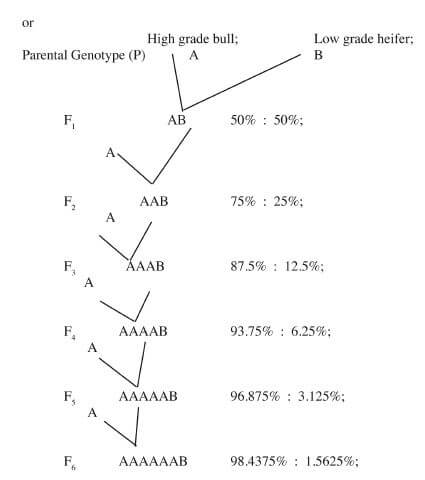
-
- Overcrowded housing;
- Fighting/pecking;
- Lack of adequate clean water which impairs egg development;
- Parasite infestation;
- Inadequate feeding;
- Old age;
- Broodiness;
- Inadequate waterers/feeders;
- Inferior feeds;
- egg eating;
- Inadequate laying nests;
- Presence of predators/strangers;
- Sudden change of feeds;
- Sudden noise;
- Sudden change of weather to cold conditions;
- Disease infection;12 x 1 (12 marks)
- Select a high grade pure breed bull; and a well managed low grade heifer; Mate them to produce a heifer with half of the sire’s genes;
-
-
- In the first week, the calf should be fed on colostrum ad libitum; In the second and third weeks; it is fed on 3.5; and 4.0kg; of whole milk per day respectively;
- From the fourth week; whole milk is gradually replaced with a mixture of whole and skim milk.
- The milk should be at body temperature;
- Calf pellets/pencils should be introduced gradually from the third week; Green fodder should be gradually introduced from the third week; milk should be divided initially into three equal parts and finally into two equal parts;
- The amount of whole milk fed should be reduced as the calf grows; Skim milk should be increased as whole milk reduces;
- From the 7th week the calf is not fed on whole milk;
- Concentrates should be increased as the calf copes with bulky solid feeds; At the 16th week the calf can be fully introduced to forage crops; 12 x 1 (12 marks)
- Liming the pond;
- Inlet channel or pipe should be opened so that fresh water fills the pond slowly; Add manure or fertiliser to encourage growth of planktons;
- Fish is introduced after about 2- 4 weeks when planktons and other water plants have grown;
- Fingerlings are obtained from recognised hatcheries; and transported with care in a water medium; using a plastic container at about 10 degrees celcius; The fingerlings are then introduced to the water during the day when the water temperature is almost the same as that of the container they were transported in; Lower the container into the pond and let it stay for sometime for acclimatisation; Allow the fingerlings to swim out of the container;
- Stock at an average rate of 5-10 fingerlings for 5m2;
- Feed the fingerlings;8 x1 (8 marks)
-
-
-
-
- The engine should be checked daily by use of dip stick and oil level maintained;
- The fuel level should be checked at the start of everyday's work and added if necessary;
- Water level in the radiator should be inspected and if low topped up; The level of electrolyte should be checked daily and topped up with distilled water if low;
- The nuts and bolts should be tightened every day;
- Grease should be applied regularly to the moving parts; Large sediments from the sediment bowl should be removed; Tyre pressure should be checked every morning before the day's work and adjusted accordingly;
- The fan-belt tension should be checked to ensure that it deflects between 1.9 cm - 2.5 cm when pushed;
- The brake shaft bearing should be greased and break fluid level maintained; Lost bolts and nuts are replaced.10 x 1 (10 marks)
-
- Moving parts should be oiled/greased regularly to reduce friction (tear and wear);
- The yoke should be properly maintained eg. repair when worn out, replaced if not repairable, properly padded;
- Tyre pressure should be checked daily before the start of work; Broken trailer bodies should be repaired;
- Loose nuts and bolts should be tightened;
- Paint it if to be stored for long to avoid rusting;
- Clean after use;
- Store under shed;
- Replace lost nuts and bolts;5 x 1 (5 marks)
-
-
- By checking the appetite and feeding - if low or excessive it indicates that the goat is sick
- Defaecation - inconsistency in texture, colour, smell, frequency and posture, presence of arasite segments, egg, larvae or blood
- Urination - irregular posture, colour and and frequency.;
- Change in temperature above or below the normal range;
- Respiratory rate - irregular respiration shown by non-rhythmic inspiration and expiration indicates ill health.
- Pulse rate - Abnormal pulse rate under normal physiological status indicates ill- health.
- Production level - Loss of weight, emaciation and reduced production rate. Abnormal discharges
- Posture - while standing or lying.
- Behaviour eg. abnormal sound, aggression, excitement.
- Appearance - eg. dullness, restlessness, pot belly, bloated.
- Movement eg. gait, eg, standing or limping when walking.
- Mucuors membranes (abnormal) eg. bright red colour, yellowish, blueish depending on disease.
- Skin/animal coat - (abnormal) starring hair, coat, sores/wounds on skin. 5 x 1 (5 marks)
-
Download KCSE 2014 Agriculture Paper 2 Questions with Marking Scheme.
Tap Here to Download for 50/-
Get on WhatsApp for 50/-
Why download?
- ✔ To read offline at any time.
- ✔ To Print at your convenience
- ✔ Share Easily with Friends / Students

